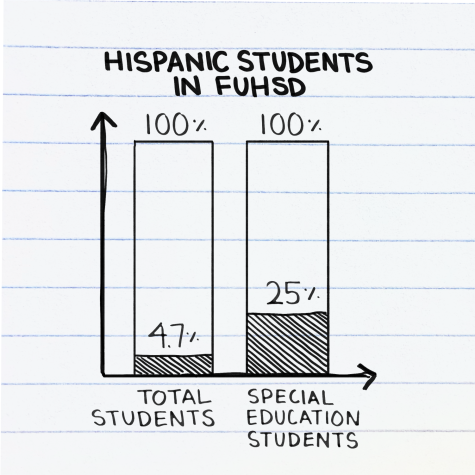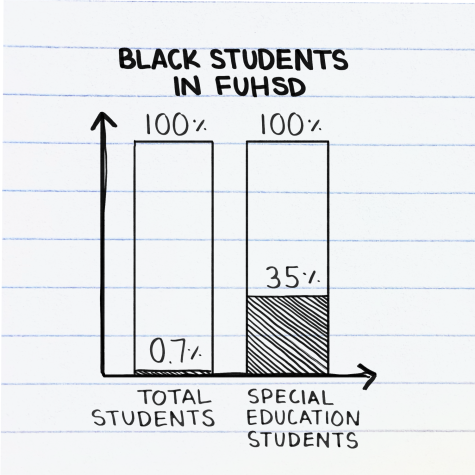The overrepresentation of minority students in special education prompts state-wide action
Examining how the district is addressing racial discrepancies in special education
March 30, 2022
For the last three years, FUHSD has been classified as significantly disproportionate in special education by the California Department of Education, meaning that students from a particular racial or ethinic group — in this case, Blacks and Latinos — are identified as special education at a greater rate than other racial groups.
According to the significant disproportionality report published by the board, in the 2019-2020 school year, 4.7% of students in FUHSD were Hispanic and 0.7% were Black. However, in special education, 25% were Hispanic and 35% were Black.

FUHSD has implemented a plan from the Comprehensive Coordinated Early Intervention Services or CCEIS, that intends to address this overrepresentation specifically by asking volunteers to take professional development on “culturally responsive teaching.” The months-long PD asked staff to go through a process of looking at current teaching practices and acknowledging inequity in how they address diverse student groups. This emphasizes teaching styles that focus on relationship building and helping students feel engaged and understand that they can make mistakes.
The plan is divided into four phases: “Getting Started,” “Data Discovery and Root Cause,” “Planning for Improvement,” and “Implementing, Evaluating and Sustaining.”
Phase one, “Getting Started,” focuses on data collection by the CCEIS leadership team, which consists of eight members who are responsible for developing a plan and monitoring implementation.
Phase two, “Data Discovery and Root Cause,” uses this data to draw trends. In 2020, 72% of Black and Hispanic students with specific learning disabilities had an IEP when entering the district. The team found that Hispanic students were overrepresented in intervention classes, and Hispanic and Black students were underrepresented in AP and Honors classes.
Through data analysis and discussion with various stakeholder groups, the team decided to focus on two root causes for this disparity: inconsistent practice in intervention and implicit bias on cultural factors in classes and assessments.

The team found that there is an inconsistent application of the Multi-Tiered System of Support intervention strategies across the district. Although schools have lists of intervention systems, they do not have a systematic review process that includes comprehensive data collection, which means that the schools and even individual teachers were practicing different intervention strategies.
The data also revealed that Black and Hispanic students have higher rates of absenteeism and lower rates of academic achievement compared to their classmates in FUHSD, forming an achievement gap most prominent in reading. Hispanic and Black students had an absentee rate of 23.2% and 13.3% respectively compared to their white and Asian classmates that had a rate of 9.5% and 2.9%.
This educational discrepancy leads the staff to implicitly lower standards for Black and Hispanic students and increasingly refer them for special education assessment. The root preconception is also reflected in the general school environment: the enrollment rate of Black and Hispanic students in Academic Foundation classes is significantly higher than in Advancement Via Individual Determination (AVID), and research found that the Academic Foundations class is seen as for failing or struggling students while AVID is seen as a support class for those capable of going to college.
Comments from parents contributed to the research:
“My son struggled with reading comprehension and it needed improvement,” one Hispanic parent said. “The teacher assumed that my son didn’t care about his future and learning. The counselor said maybe he needs special education.”
“My son is very energetic,” another Hispanic parent said. “The first thing they want to do is ‘Let me help you.’ No other alternatives, to try other strategies. The medication, every time the physician would offer me the medication.”
“The narrative the parents are told, the narrative the students are told, ‘You are not going to college,’” one Black parent said. “It is unfair that we have to prove we are worthy of success.”
“One [staff member] said out loud to my son, in front of me. ‘You are not going to college,’’ another Black parent said. “She could not see how hurtful those words were to him and to me.”
FUHSD administration is attempting to address this issue through creating equity task forces at each of its schools, but according to the report, not much progress has been made so far.

Phase Three, “Planning for Improvement,” focuses on a review of policies, practices and procedures, creating focus groups and measurable outcomes to address the root causes identified in Phase Two. The main goal is to increase academic achievements for ninth graders in Literature & Writing and Algebra 1 who were previously failing or who qualified for other criteria such as chronic absenteeism. At Fremont High School and Homestead High School, these focus groups are put in culturally responsive classrooms and their progress is tracked by the leadership team.
Phase four, “Implementing, Evaluating and Sustaining,” is a continuation of phase three and focuses on implementing an action plan. This means collecting, analyzing and presenting data to stakeholders on a quarterly basis. At stakeholder meetings, members discuss implementation plans and evaluate the impact it had on focus groups. Once the impact is determined, future funding will be considered.
—
To learn more about disproportionality in special education:
Significant Disproportionality in Special Education: Current Trends and Actions for Impact: https://www.ncld.org/wp-content/uploads/2020/10/2020-NCLD-Disproportionality_Trends-and-Actions-for-Impact_FINAL-1.pdf
Identifying the root causes of disproportionality: https://paperzz.com/doc/7528733/identifying-root-causes-of-disproportionalit–brief-
Unconscious Bias: When Good Intentions Aren’t Enough: https://www.responsiveclassroom.org/wp-content/uploads/2017/10/Unconscious-Bias_Ed-Leadership.pdf
Distinguishing Difference From Disability: https://spptap.org/distinguishing-difference-from-disability-the-common-causes-of-racial-ethnic-disproportionality-in-special-education-pdf-outside-source/
